weight OLDSMOBILE SILHOUETTE 1995 Owners Manual
[x] Cancel search | Manufacturer: OLDSMOBILE, Model Year: 1995, Model line: SILHOUETTE, Model: OLDSMOBILE SILHOUETTE 1995Pages: 390, PDF Size: 20.27 MB
Page 13 of 390

Driver's 6-Way Power Seat (Option)
To adjust the driver's six-way power seat:
Front Control (A): Raise the front of the seat by
holding the switch up. Hold the switch down to lower
the front
of the seat.
Rear Control (C): Raise the rear of the seat by holding
the switch up. Hold the switch down to lower the rear of
the seat.
Reclining Front Seatbacks
To adjust the seatback, rotate this knob. It is easier to
recline the seat if you lean forward, taking your weight
off the seatback.
Center Control (B): Move the seat forward or backward
by holding the control
to the front or back. Raise or lower
the seat by holding the control
up or down.
1-3
ProCarManuals.com
Page 50 of 390

Built-In Child Restraint (Option)
Each seat that has the built-in child restraint option fits in\
only one location in your vehicle.
To find out where a seat
that has a built-in child restraint must be located in your
vehicle,
see “Removable Rear Bucket Seats” in the Index.
11 you have a rear seat with the optional built-in child
restraint, refer to this picture to become familiar with the
parts
of each child seat and 5-point harness listed next.
A. Child Head Restraint
B. Head Restraint Release Strap C.
Shoulder Harness Straps
D. Shoulder Harness Clip
E. Removable Pad
E Seat Belt Latch Plates
G. Buckle
H. Seat Belt Buckle Release Button (Red)
I. Shoulder Harness Release Strap (Black)
J. Shoulder Harness Adjustment Strap (Gray)
K. Child Restraint Cushion
This child restraint system conforms
to all applicable
Federal motor vehicle safety standards.
This child restraint
is designed for use only by children
who weigh between
20 and 40 pounds (9 and 18 kg) and
whose height is
40 inches (102 cm) or less and who are
capable of sitting upright alone.
In addition, the child should be one year old or more and
at least 28 inches (71 cm) in height. It is important to
use an approved, rear-facing infant restraint for a full
year to allow the neck and spine to develop enough to
support the weight of the child’s head in the event
of a
collision.
1-40
ProCarManuals.com
Page 105 of 390

Leaving Your Vehicle With the Engine
Running
If you have to leave your vehicle with the engine
running, be sure your vehicle is in PARK (P) and your
parking brake is firmly set before you leave it. After
you’ve moved the shift lever into the PARK (P)
position, hold the regular brake pedal down. Then, see if
you can move the shift lever away from PARK (P)
without first pulling it toward you.
If you can, it means that the shift lever wasn’t fully
locked into PARK
(P).
Torque Lock
If you are parking on a hill and you don’t shift your
transaxle into PARK (P) properly, the weight
of the
vehicle may put too much force on the parking pawl in
the transaxle. You may find it difficult to pull the shift
lever out of PARK (P). This
is called “torque lock.” To
prevent torque lock, set the parking brake and then shift
into PARK (P) properly before you leave the driver’s
seat.
To find out how, see “Shifting Into PARK (P)” in
the Index.
When you are ready to drive, move the shift lever out of
PARK (P) before you release the parking brake.
If “torque
lock” does occur, you may need to have
another vehicle push yours a little uphill to take some of
the pressure from the transaxle,
so you can pull the shift
lever out of PARK (P).
2-35
ProCarManuals.com
Page 132 of 390
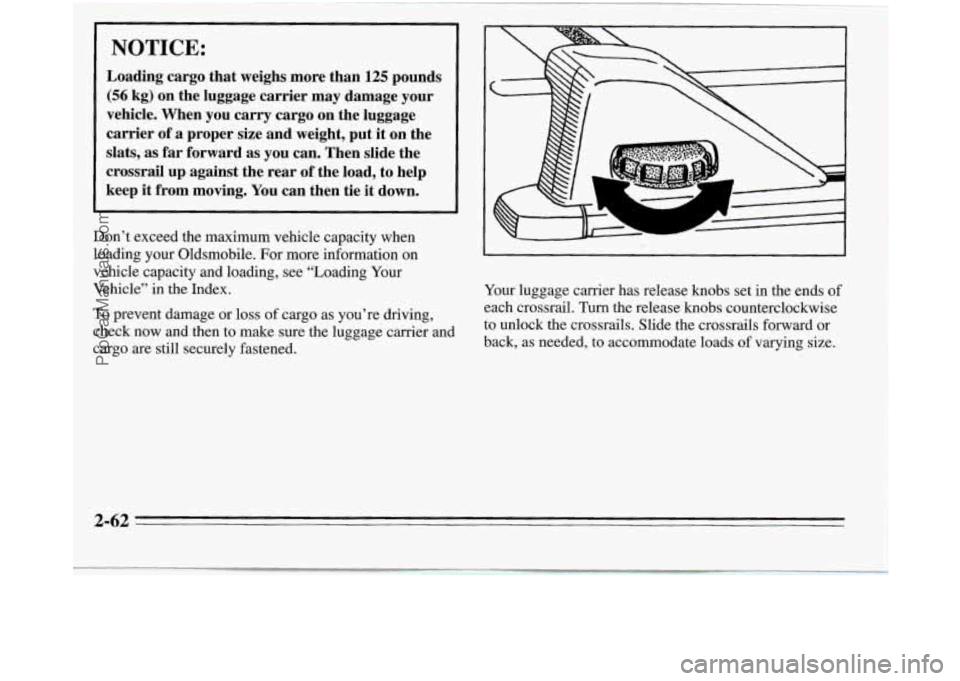
NOTICE:
Loading cargo that weighs more than 125 pounds
(56 kg) on the luggage carrier may damage your
vehicle. When you carry cargo
on the luggage
carrier of
a proper size and weight, put it on the
slats,
as far forward as you can. Then slide the
crossrail up against the rear
of the load, to help
keep
it from moving. You can then tie it down.
Don’t exceed the maximum vehicle capacity when
loading your Oldsmobile. For more information on
vehicle capacity and loading, see “Loading Your
Vehicle” in the Index.
To prevent damage or loss of cargo as you’re driving,
check now and then to make sure the luggage carrier and
cargo are still securely fastened.
4 I
Your luggage carrier has release knobs set in the ends of
each crossrail. Turn the release
knobs counterclockwise
to unlock the crossrails. Slide the crossrails forward or
back, as needed, to accommodate loads
of varying size.
2-62
ProCarManuals.com
Page 138 of 390
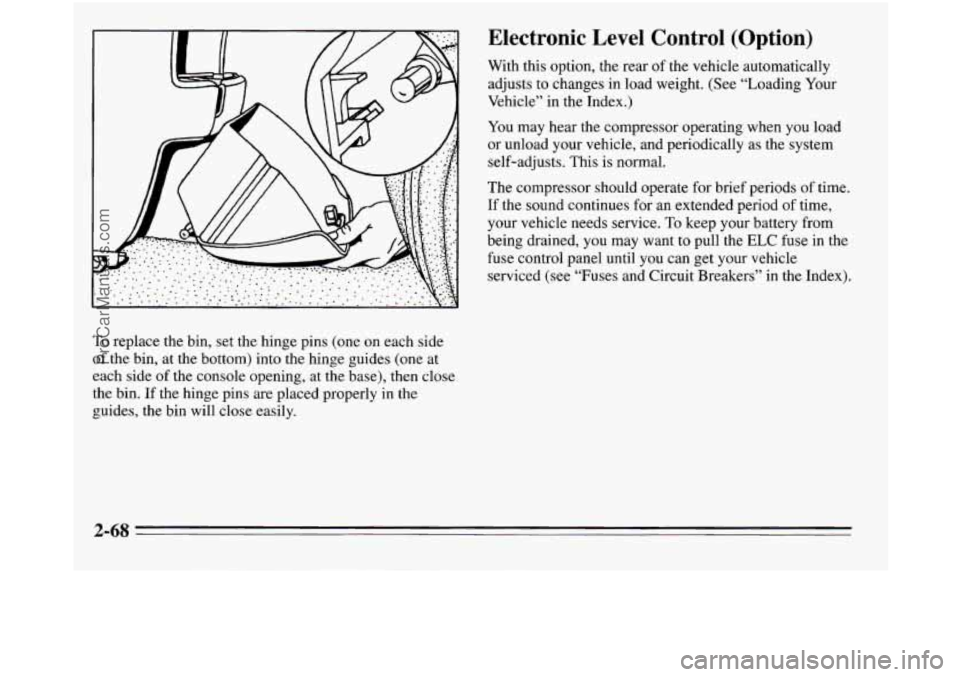
Electronic Level Control (Option)
With this option, the rear of the vehicle automatically
adjusts to changes in load weight. (See “Loading Your
Vehicle” in the Index.)
You may hear the compressor operating when you load
or unload your vehicle, and periodically as the system
self-adjusts. This is normal.
The compressor should operate for brief periods
of time.
If the sound continues for an extended period
of time,
your vehicle needs service.
To keep your battery from
being drained, you may want to pull the
ELC fuse in the
fuse control panel until you can get your vehicle
serviced (see “Fuses and Circuit Breakers’’ in the Index).
To replace the bin, set the hinge pins (one on each side
of the bin, at the bottom) into the hinge guides (one at
each side
of the console opening, at the base), then close
the bin.
If the hinge pins are placed properly in the
guides, the bin will close easily.
2-68
ProCarManuals.com
Page 184 of 390

Drunken Driving
Death and injury associated with drinking and driving is
a national tragedy. It’s the number
one contributor to the
highway death
toll, claiming thousands of victims every
year.
Alcohol affects four things that anyone needs to drive a
vehicle:
Judgment
Muscular Coordination
Vision
0 Attentiveness
Police records show that almost half of all motor
vehicle-related deaths involve alcohol. In most cases,
these deaths are the result of someone who was drinking
and driving.
In recent years, some 18,000 annual motor
vehicle-related deaths have been associated with the use
of alcohol, with more than
300,000 people injured.
Many adults
-- by some estimates, nearly half the adult
population
-- choose never to drink alcohol, so they
never drive after drinking. For persons under 21, it’s
against the law in every U.S. state to drink alcohol.
There are good medical, psychological and
developmental reasons for these laws.
The obvious way to solve this highway safety problem
is for people never to drink alcohol and then drive. But
what if people do? How much
is “too much” if the
driver plans
to drive? It’s a lot less than many might
think. Although it depends on each person and situation,
here is some general information
on the problem.
The Blood Alcohol Concentration (BAC)
of someone
who is drinking depends upon four things:
0 How much alcohoI consumed
0 The drinker’s body weight
The amount of food that is consumed before and
during drinking
The length of time it has taken the drinker to
consume the alcohol
According to the American Medical Association, a
180-pound
(82 kg) person who drinks three 12-ounce
(355 ml) bottles of beer in an hour will end up with a
BAC of about
0.06 percent. The person would reach the
same BAC by drinking three 4-ounce (120 ml) glasses
of wine or three mixed drinks if each had 1-1/2 ounces
(45 ml) of a liquor like whiskey, gin or vodka.
4-2
ProCarManuals.com
Page 185 of 390
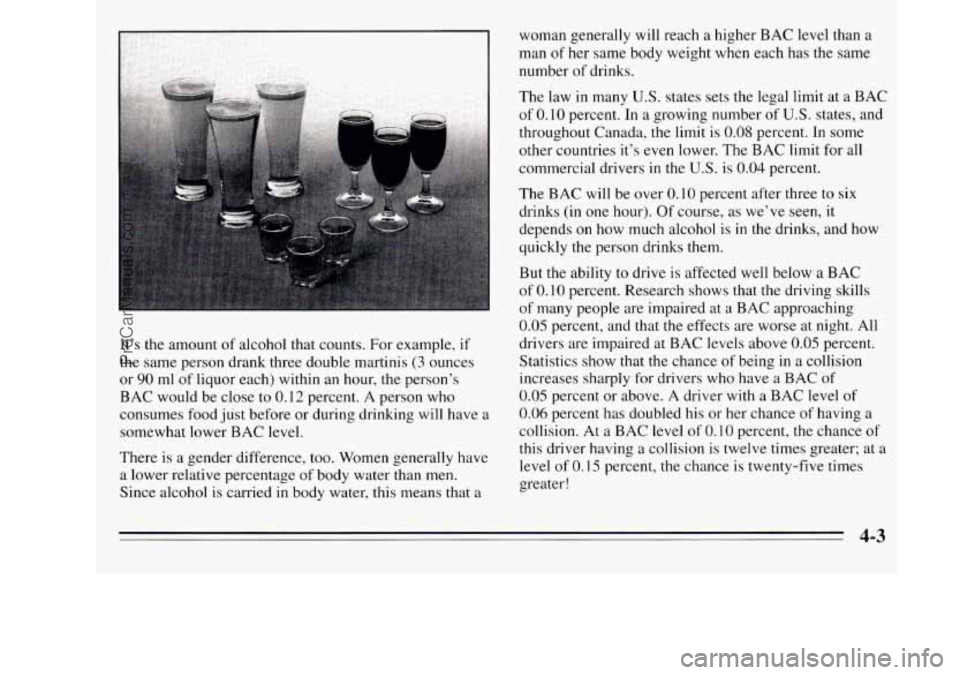
It’s the amount of alcohol that counts. For example, if
the same person drank three double martinis
(3 ounces
or
90 ml of liquor each) within an hour, the person’s
BAC would be close to
0.12 percent. A person who
consumes food just before or during drinking will have a
somewhat lower BAC level.
There
is a gender difference, too. Women generally have
a lower relative percentage of body water than men.
Since alcohol is carried in body water, this means that a woman
generally will reach a higher BAC level than a
man of her same body weight when each has the same
number of drinks.
The law in many
U.S. states sets the legal limit at a BAC
of
0.10 percent. In a growing number of U.S. states, and
throughout Canada, the limit is
0.08 percent. In some
other countries it’s even lower. The BAC limit for all
commercial drivers
in the U.S. is 0.04 percent.
The BAC will be over
0.10 percent after three to six
drinks (in one hour). Of course, as we’ve seen, it
depends on how much alcohol is in the drinks, and how
quickly the person drinks them.
But the ability to drive
is affected well below a BAC
of
0.10 percent. Research shows that the driving skills
of many people are impaired at a BAC approaching
0.05 percent, and that the effects are worse at night. All
drivers are impaired at BAC levels above
0.05 percent.
Statistics show that the chance of being in a collision
increases sharply for drivers who have a BAC
of
0.05 percent or above. A driver with a BAC level of
0.06 percent has doubled his or her chance of having a
collision. At
a BAC level of 0.10 percent, the chance of
this driver having a collision is twelve times greater; at a
level
of 0.15 percent, the chance is twenty-five times
greater
!
4-3
ProCarManuals.com
Page 211 of 390
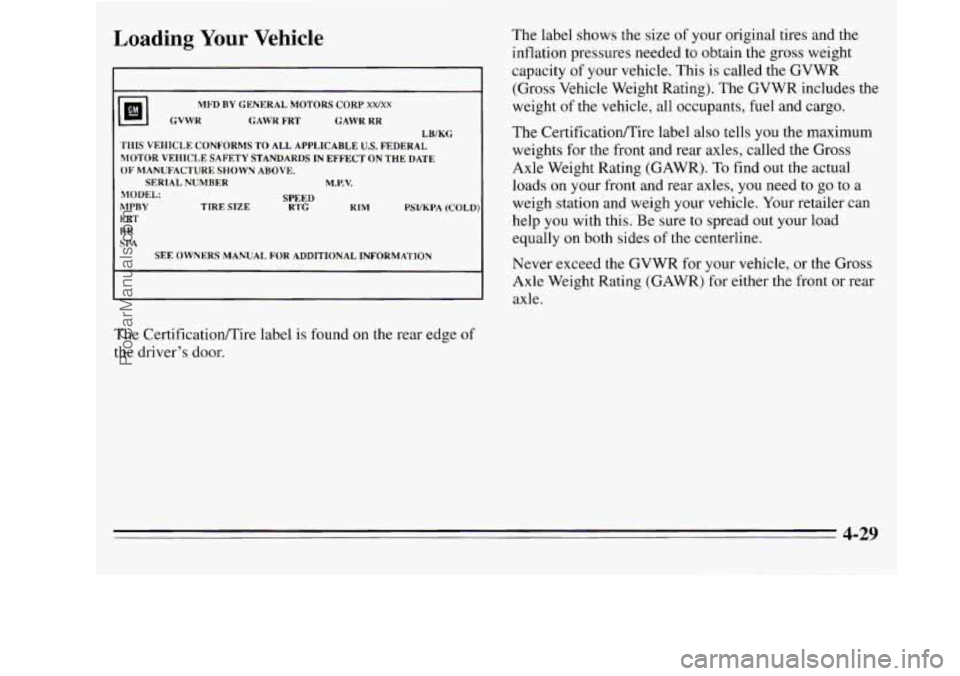
Loading Your Vehicle
11BI CVWR
MFD BY GENERAL MOTORS CORP XWXX
GAWR FRT GAWR RR LB/KG
THIS VEHICLE CONFORMS TO ALL APPLICABLE U.S. FEDERAL
MOTOR VEHICLE SAFETY STANDARDS IN EFFECT ON THE DATE
OF MANUFACTURE SHOWN ABOVE.
SERIAL NUMBER M.P.V.
MODEL:
MPBY
FRT
RR
SPA
SPEED
TIRE SIZE RTG RIM PSI/KPA (COLD
SEE OWNERS MANUAL FOR ADDITIONAL INFORMATION
The CertificatiodTire label is found on the rear edge of
the driver's door. The label
shows the size
of your original tires and the
inflation pressures needed to obtain the gross weight
capacity of your vehicle. This is called the GVWR
(Gross Vehicle Weight Rating). The GVWR includes the
weight
of the vehicle, all occupants, fuel and cargo.
The CertificatiodTire label also tells you the maximum
weights for the front and rear axles, called the Gross
Axle Weight Rating (GAWR). To find out the actual
loads on your front and rear axles,
you need to go to a
weigh station and weigh your vehicle. Your retailer can
help you with this. Be sure to spread out your load
equally on both sides of the centerline.
Never exceed the GVWR for your vehicle,
or the Gross
Axle Weight Rating (GAWR) for either the front or rear
axle.
4-29
ProCarManuals.com
Page 212 of 390
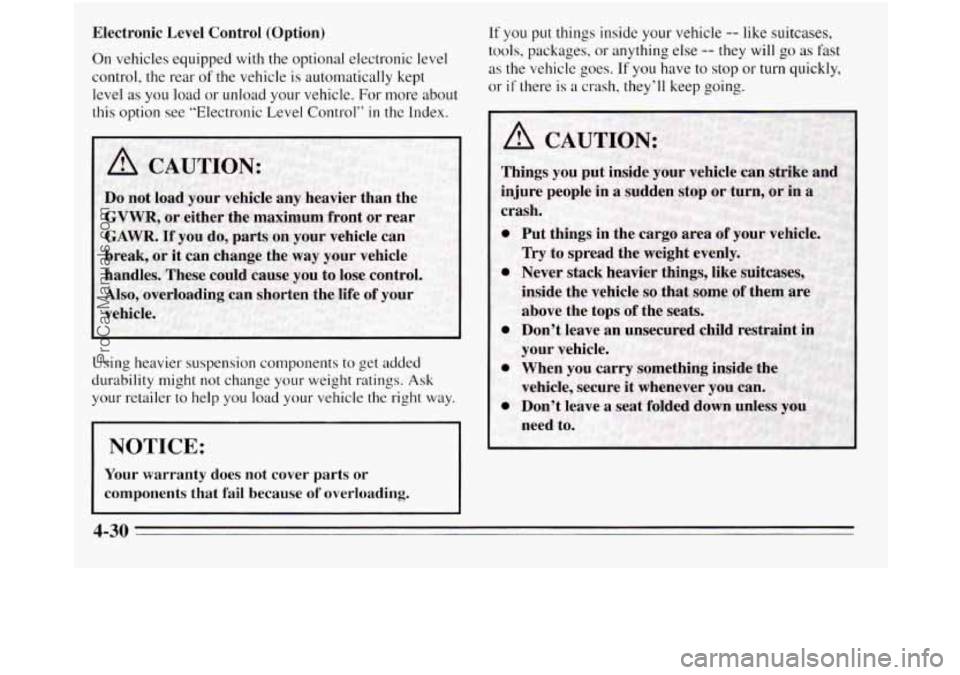
Electronic Level Control (Option)
On vehicles equipped with the optional electronic level
control, the rear
of the vehicle is automatically kept
level as
you load or unload your vehicle. For more about
this option see “Electronic Level Control”
in the Index.
Using heavier suspension components to get added
durability might not change your weight ratings.
Ask
your retailer to help you load your vehicle the right way.
NOTICE:
Your warranty does not cover parts or
components that fail because of overloading.
If you put things inside your vehicle -- like suitcases,
tools, packages, or anything else
-- they will go as fast
as the vehicle goes. If you have to stop or turn quickly,
or
if there is a crash, they’ll keep going.
4-30
ProCarManuals.com
Page 213 of 390
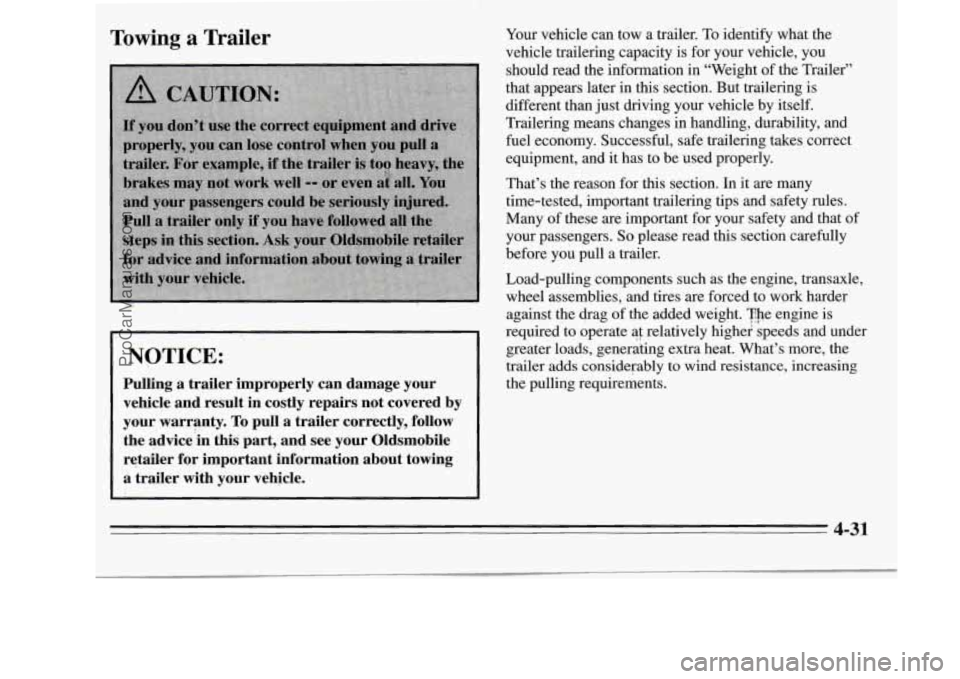
Towing a Trailer
NOTICE:
Pulling a trailer improperly can damage your vehicle and’result in costly repairs not covered by
your warranty.
To pull a trailer correctly, follow
the advice‘in this part, and see your Oldsmobile
retailer for important information about towing a trailer with your vehicle.
Your vehicle can tow a trailer. To identify what the
vehicle trailering capacity is for your vehicle, you
should read the information in “Weight of the Trailer”
that appears later in this section. But trailering is
different than just driving your vehicle by itself.
Trailering means changes in handling, durability, and
fuel economy. Successful, safe trailering takes correct
equipment, and it has to be used properly.
That’s the reason for this section. In it are many
time-tested, important trailering tips and safety rules.
Many of these are important for your safety and that of
your passengers.
So please read this section carefully
before you pull a trailer.
Load-pulling components such as the engine, transaxle,
wheel assemblies, and tires are forced to work harder
against the drag of the added weight. The engine is
required
‘to operate ai relatively highei speeds and under
greater loads, generating extra heat. What’s more, the
trailer adds considerably to wind resistance, increasing
the pulling requirements.
4-31
ProCarManuals.com